Okami Review
Okami
If you thought that the PlayStation 2 was dead, you were dead wrong. Okami proves that there's life left in the old girl yet.

Verdict
Key Specifications
- Review Price: £24.99
”’Platform: PlayStation 2”’
We always knew it would age well, but over six years after its UK launch the PS2 has turned into the Clint Eastwood of the console world, still quietly knocking out classics at a time when its last-generation peers have quietly retired to a life of inactivity bar the occasional EA or Activision franchise update. Impressively Okami is only one of a series of exclusive heavy hitters launching in the UK in the next five months. More impressively, when many so-called next-generation games struggle to make a visual or emotional impression, it’s a game that almost effortlessly does both. So, if you’ve relegated the old Sony system to the attic or kid’s bedroom, then it’s time you reclaimed it right now. It’s time to say hello to the first truly essential game of the year.

The reasons why come down to a winning combination of art and humour. The first is hugely important. The novelty factor of cel shading wore off long ago when even the most basic kiddie racer started using it as a kind of visual statement, but Okami is one of those games that really uses the potential of the technique. Here it invokes both the spirit of classical Japanese scroll painting and a connection with ancient mythology. Its painted world – a rich concoction of ever shifting line and colour – might look strange in still images but – believe me – it’s stunning in motion. There are times when the game’s huge flourishes of camera movement or bursting colour are practically overwhelming in a way many more technically advanced titles can only dream of. The visual style is a brilliant way to bring a world of ancient folklore to life, but only one of many things that makes Okami so special.
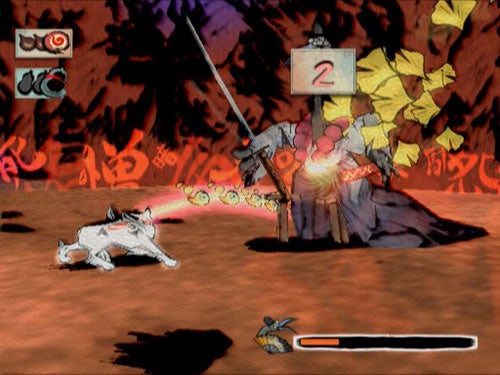
You see, in this game the paintbrush isn’t just the inspiration for the look, but also the game’s signature weapon. To make the explanation as brief as possible – something you wish the interminable intro movie would have done – you play the Japanese sun god Amaritsu, incarnate in the form of a white wolf, and set on banishing the demon Orochi back into the darkness from whence he came. Despite his naturalistic four-legged form and subsequent lack of opposable thumbs, Amaritsu proves a dab hand with a range of celestial weapons, but none is the equal of his world-changing paintbrush. At nearly any point in the game, you can press the R1 button to hold the screen in a monochrome stasis, then use a stick-controlled cursor to paint elegant strokes onto the frozen image. Different strokes and shapes have different powers; some slash defenceless enemies or obstructive rocks in half, others bring trees into bloom or repair broken bridges. Others still create bombs, summon floating lily-pads or draw vines which hoist Amaritsu high into the air. In effect, the paintbrush becomes the equivalent of the various tools Link finds in the Zelda games, enabling our hero to reach new areas, solve specific puzzles and even defeat the most fearsome monsters just when it looks like all hope is lost.
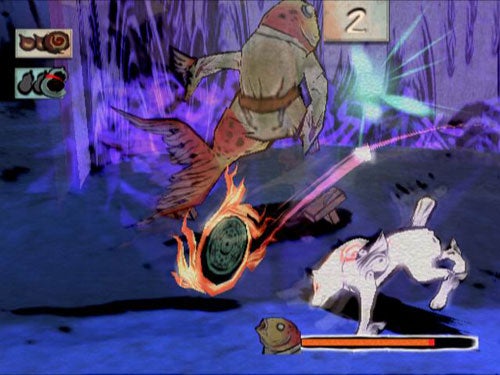
Get used to Zelda comparisons, because Okami constantly invites them. This is probably the closest anyone outside of Nintendo has come to developing something that can stand up to its most treasured series. The basic gameplay is very similar, and the structure begins along the same sort of lines as the last few Legends. You explore an area, solve some puzzles and complete some tasks, open up a dungeon, learn new skills, battle the boss then use your new found powers to discover the next section. It’s hugely traditional, but it definitely works.
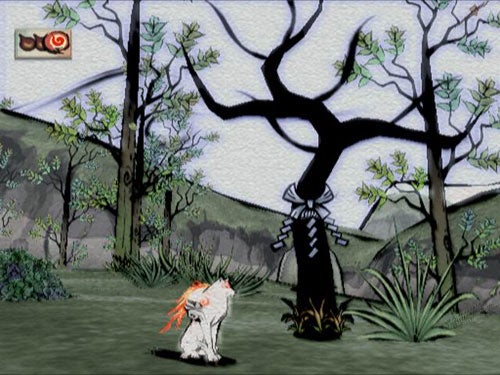
What’s more, Okami hits a similar balance between the epic, fairy-tale quest and having a whole smorgasbord of simple, oddly domestic little tasks that you just have to complete if you want the bonus heart-containers (here solar cells) and item upgrades that will make later parts of the game more manageable. In Okami, you’re a force of natural goodness in a world corrupted by the demon’s pollution, so it’s only right that you’ll spend a portion of your time rescuing withered cherry trees, feeding animals and even helping poor villagers with the troubles of their daily lives. It’s surprising that so few other games bar Zelda, GTA and Oblivion have ever seemed to understand this: that a good game doesn’t need to be all about the quest and gaining power, it can also be about playing around and just getting involved in the game’s rich world.
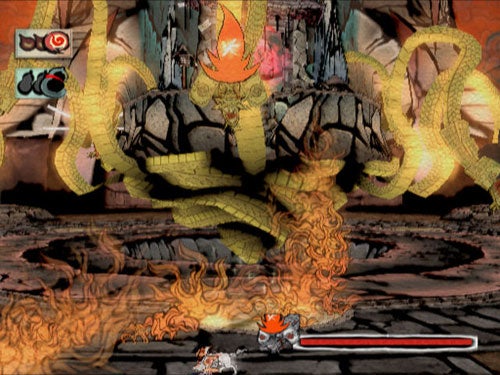
And this is where the humour comes in. Any game that starts up with a good fifteen minutes of waffling background preamble is in danger of taking itself too seriously, but Okami’s greatest strength is that it doesn’t. Instead, it constantly undercuts itself with knowing wit and lively charm. Like Link in the Zelda games, Amaritsu is a bit of a blank canvas, with no dialogue or overbearing personality of his own, but he’s surrounded by some of the most bizarre and enjoyable characters you’ll ever meet.
Your constant companion – Okami’s equivalent of Zelda’s Navi or Midna – is a jumped-up bug by the name of Issan, with a smart mouth, artistic pretensions and a rather curious leering attitude to nubile female nature spirits. During your quest you’ll also encounter a drunken Samurai torn between his obvious cowardice and his pitiful need for admiration and a weird, style-conscious warrior with a yen for introducing poncy French phrases into his speech, not to mention would-be street mole and sparrow gangsters and a dog that’s ashamed of his weak-spirited young master. The original team at Clover Studios must take credit for assembling this wonderful cast, but kudos too goes to the team that worked on the translation. I wouldn’t say that Okami has had me rolling in the aisles, but it’s certainly the sort of tale that keeps you well amused.
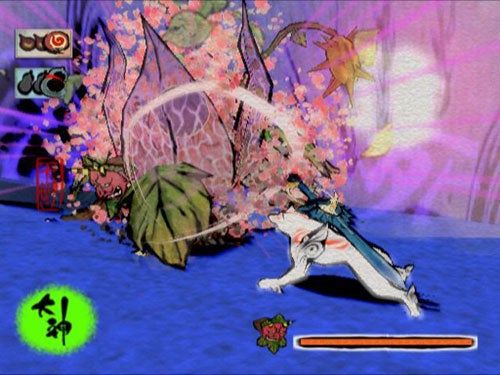
Stranger still, as the game goes on something really peculiar happens: the tone seems to shift more and more away from the earnest adventure side of things and towards the oddball antics that should really be going on in the background. I’m not sure how much this was a conscious decision, but while the game does lose some momentum halfway through, Okami soon recovers to tread a perfect balance between these two aspects. If you want an epic story of good against evil, then you’ve got it – and Okami even goes big on the combat mechanics and weapon upgrades that Capcom’s fanbase takes for granted. But if you take time to chill out, complete side-quests and just enjoy the vibe you’ll have an even better time.
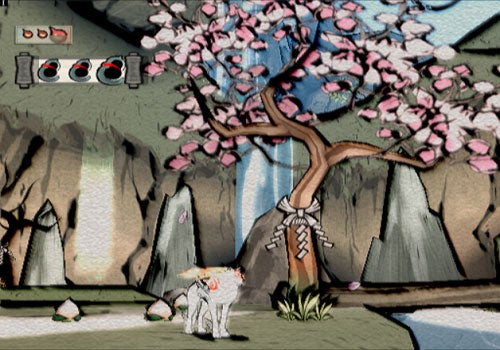
Is it as good as Twilight Princess? Very nearly, but not quite. It’s never quite as stirring, there are times when your tame bug’s hints leave too little to the imagination, and the camera goes horribly amiss at the worst possible moments. What’s more a few of the boss battles are annoying, and it isn’t quite as long a game (though it’s significantly longer than The Wind Waker). Finally, while the dungeons and puzzles are imaginative and engaging, it must be said that nobody does them quite like Nintendo, and Okami only occasionally hits the same sort of heights. However, the fact that this game can be mentioned in the same breath as Zelda says it all. Beautiful, inspiring and unique, Okami is the sort of game that any serious gamer ought to try, then badger friends and family until they experience it too. Just get it – you won’t regret it.
”’Verdict”’
An outstanding spin on the Zelda style, and proof that the PS2 can still surprise in the age of the PS3 and 360. Highly recommended.

